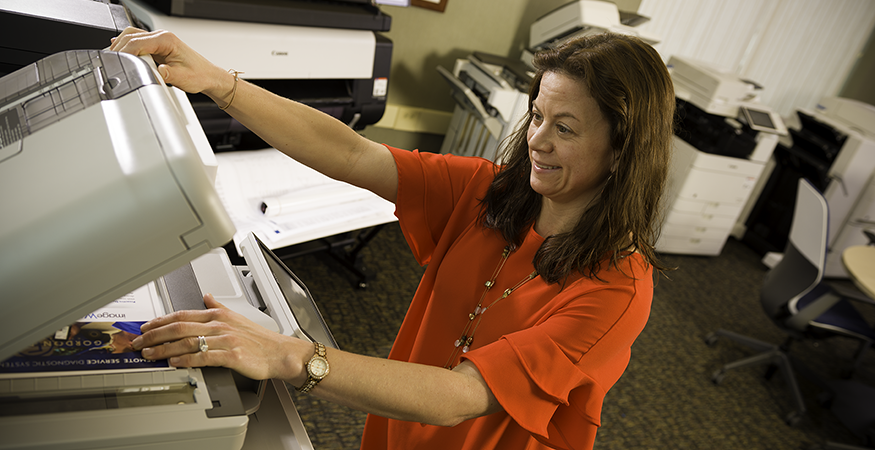When is the last time you looked at your office scanner? Most of us don’t really think about imaging devices – until there is a big job or project that demands heavy-duty scanning capabilities.
If you’re looking for a new scanner, or just trying to get more out of your existing device, we’re here to help. First, we will explain exactly what the modern office scanner can do. Then, we will dive into some lesser-known capabilities of a scanner that will help you get more work done, faster.
Small, low volume scanners may have a simple sheet feeder that takes in paper and runs it past the imaging unit. However, once the paper runs past the imaging unit, a lot of different features can come into play.
To understand what an office scanner or multifunction device can do, you need to know that your scanner has different levels of functionality. The three levels are:
- The scanner hardware
- Drivers and software that run the scanner
- Applications you may use to manage scanned documents
Let’s take a closer look at each of these and how they can best be used for optimal scanning results.
RELATED: How to Scan Multiple Pages into One PDF
1. Hardware Functions
First, consider the scanner hardware. A scanner’s capability depends in large part on the complexity of the hardware. There are three types of scanners available: sheet fed scanner, flatbed and handheld scanners. Drum scanners are relatively rare and are used to print high-quality images for the publishing industry or scientific purposes. Sheet fed and flatbed scanners are commonly found in corporate, healthcare and education-related organizations while handheld scanners are commonly found in manufacturing, warehouse and mobile work environments.
Depending on the scale of your scanning work, there is a wide range of devices to choose from. For example, the Canon imageFORMULA P-208II will be effective if you need to scan up to eight pages a minute or less than 50 pages in a typical day. This model is ideal for occasional office needs or for remote workers needing scanning services.
Meanwhile, the Canon DR-M1060II can scan up to 60 pages per minute and process up to 7,500 pages in a typical workday. This model features both U-turn and straight paper feed paths for the ability to scan one or both sides of a page.
However, one factor many scanner users may not consider is hidden in the back of a scanner or multifunction device. That is the connection to your computer. It doesn’t matter how many pages per minute a machine can scan if you don’t have a connection fast enough that can simultaneously transmit the image to your workstations for storage or finishing work.
2. Driver Functions
Scanner driver functions vary greatly at the driver level. Drivers are the software that make the hardware work. Basic drivers will capture your scans and output the images in a specified format.
However, more capable drivers can detect misfeeds, adjust brightness, enhance images (remove imperfections), detect page sizes and even enhance your scanned images. The ability to convert documents at the machine is now standard on Canon scanners and multi-function devices. Other features include:
- Skew Detection The scanner stops feeding when a skewed document is detected as it touches the edges of the feeder inlet
- Staple Detection The scanner stops feeding when it detects the presence of stapled documents
- Dust Detection Detects dust in the scanning unit and performs error processing as needed
- Ultrasonic Double Feed Detection The scanner stops feeding when the ultrasonic sensor detects that two or more document pages are fed at the same time
- Double feed detection by length The scanner stops feeding when a double feed is detected by comparing document page lengths
- Prescan At the start of scanning, this function prescans the first page and pauses so that you can adjust brightness and contrast before resuming scanning
- Text Orientation Detection The text orientation on each page is detected, and the scanned image is rotated in 90-degree increments as necessary for normalization. This corrects page orientation after scanning which automatically adjusts documents placed upside down in the feeder
3. Application Functions
The third level of capability is found at the application level. Many scanners come with bundled applications, like Capture OnTouch, which is provided with Canon scanners. The software provides additional features such as searchable PDF creation, editing tools and mobile scanning support. Perhaps the most important new function scanning software now provides is cloud connectors.
For example, Canon scanners can automatically scan and send documents to any of these cloud providers: Google Drive, Dropbox, SharePoint, Microsoft OneDrive, Box and Evernote. In addition, you’ll never have to lug reams of documents around because your document library can be found in the cloud. It is also easy to connect Canon and other scanners to a Document Management System to scan, sort and file documents electronically for easy retrieval.
If you are a law firm, accounting firm archivist or other organization with specialized needs, you will be looking for an application with redaction, bookmarking, metadata creations tools, Bates stamping or conversion capabilities for special formats. Most scanners can automatically convert to files like Microsoft Excel or Word, PDFs or image files, but large, detailed or specialized documents like architectural blueprints will demand high resolutions and support for large sizes.
As you can see, the difference between scanners is more than determining whether you need 10 pages per minute (ppm) or 120 ppm. The bigger question when choosing a scanner is knowing your chosen machine has the drivers and applications to handle your most complicated workload.
Today’s scanners come with amazing built-in capabilities – if you know how to use them. Want to talk to Gordon Flesch Company’s scanning experts? Reach out today!










